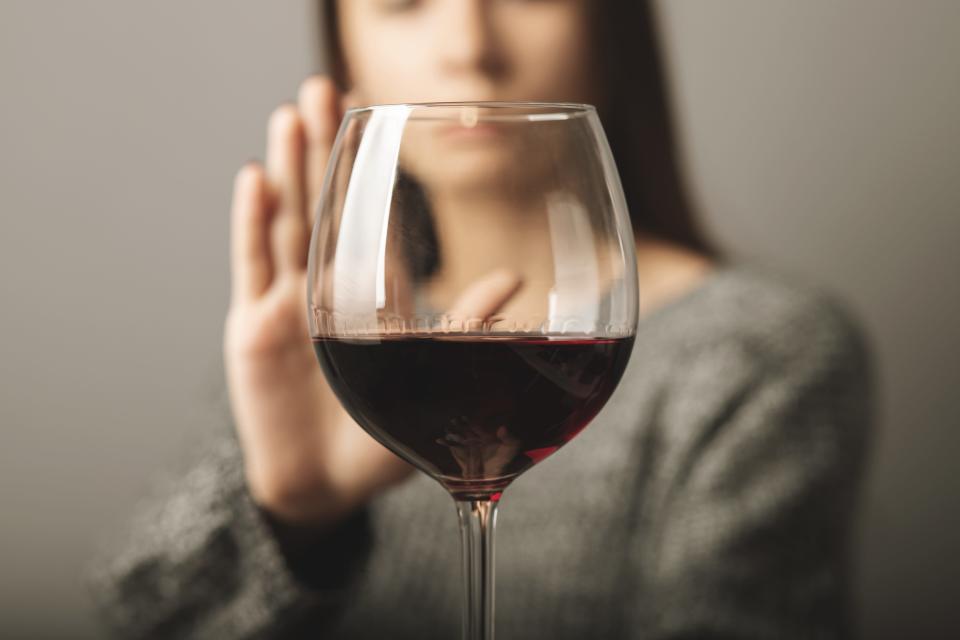Are Asians 'allergic' to alcohol? How the dreaded 'glow' makes drinking feel isolating
For games, we have tallboys. For parties, rounds of tequila shots. For work events, wine and cocktails. Alcohol is the social lubricant, easing anxiety and guaranteeing fun. But as I sip on whatever concoction slips past my lips, there's only one thought plaguing my mind: my face.
It's burning. It's itching. I can feel a rash-like discomfort spreading across my cheeks and toward my neck. It's physically unbearable and uncomfortable. Emotionally it's worse. I hear the murmurs and see the side-eyed glances clock my splotchy complexion. "Do I look drunk?" I wonder around my colleagues. "Am I noticeably red?" I frantically ask my friends, ready to douse my cheeks in heavy-duty concealer.
Scientifically, this phenomenon is called alcohol flush syndrome. More colloquially, it's known as "Asian flush" (though it can affect non-Asians as well). Many of us (about 40% to be exact), are seemingly "allergic" to alcohol, hence the inflammatory reaction. Specifically, it's caused by a genetic mutation that prevents the metabolization of alcohol.
Experiencing the infamous glow can be isolating in several ways. "After just downing half a glass, some already feel their headaches coming. Their heart may be beating faster," says Saw Hoon Lim, a senior lecturer in the department of biochemistry and pharmacology at the University of Melbourne in Australia. "You feel and look a bit hungover or drunk, and that might be embarrassing to some extent."
However, Lim, who also experiences facial flushing herself, says it's important to reframe how we view Asian flush – less as a sign of weakness and more as a "blessing in disguise."
"I know it's not ideal. I know it's hard to drink," she says. "But it's your body's way of telling you that you're intaking something a little dangerous, something that's not good for your body."

Someone not drinking alcohol?: It's none of your business.
What causes 'Asian flush'?
For most people, the toxic parts of alcohol are broken down and metabolized by an enzyme called aldehyde dehydrogenase (or ALDH2). But many East Asians like myself are ALDH2-deficient. That leads to the buildup of toxins in our body and the experience of Asian flush.
In other words, "our bodies are intolerant to alcohol," Lim says. Beyond what's visible on the outside, "we feel nauseous, sometimes itchiness on the skin. … Physiologically, the body feels very (bad) because the ALDH2 is less functional."
Headache? Dry mouth? What to know about hangovers and whether those 'cures' actually work
Is alcohol a depressant? If so, what are the effects?
Beyond redness, 'Asian flush' could signal bigger health risks
To this day, I've scrambled to find a cure to mask the redness. Pepcid, an antihistamine typically used for heartburn relief, is one common (but temporary) remedy to reduce inflammation. There's even a market for "glow patches," which claim to transfer antioxidants and vitamins into the bloodstream. Neither of these, however, are FDA-approved for this condition.
There is no known cure for this genetic mutation. The best thing we can do is to listen to our bodies – and research – and stop drinking. For one, numerous studies have found that Asians with "flush" are already at an increased risk for esophageal, throat and mouth cancers because of the deficient enzyme. Using histamine blockers like Pepcid to reduce these effects, expert Daryl L. Davies warns, can escalate alcohol intake and exacerbate these cancerous outcomes.
"Your body is giving you signals. It's not tolerating the alcohol, and it's saying to limit your consumption. ... And yet when you get that peer pressure in a business or party setting, people try to drink through it," says Davies, co-director of the Institute of Addiction Science at USC.
"These (histamine) blockers like Pepcid are exactly the wrong approach, because all that's doing is masking the outcome. It's not breaking down the enzyme, so now you have that circulating in your body for even longer periods of time without the consequences of your body telling you to slow down."
So why do I keep drinking through the flush?
Turning down a drink or two isn't as easy as it sounds when alcohol is not only socially acceptable but also socially pervasive. Those who have grown up in Asian households also understand the pressure to "push through the flush" as a badge of honor.
But I can't help but wonder: Is drinking for the sake of "fitting in" worth the discomfort and "lobster face"?
Jada Pinkett Smith: said 'wine culture' normalized her heavy drinking. How much is too much?
A resounding no is instinctual, yet I often find myself caving anyway, out of fear that it'll make me more of a social pariah to opt for a mocktail than to turn beet-red. But Lei Yu, a Rutgers University professor who teaches in the department of genetics and the Center of Alcohol and Substance Use Studies, believes more people would be compassionate if they understood what Asian flush really was: alcohol intolerance.
"The issue is in our heads," says Yu, who suggests reframing it as a medical condition rather than a cosmetic one. "There's nothing to be ashamed of for people who have lactose intolerance, right? There's no shame or stigma, and people always say, 'Oh, I don't drink dairy products.' There's nothing wrong with that."
If we tell ourselves we're intolerant to alcohol, "we don't marginalize ourselves," Yu points out. "You don't isolate yourself or feel bad, and then you'll have a healthier lifestyle."
That isn't to say I won't indulge in the occasional martini or still go out drinking with my friends. I may, however, just cradle the same glass and take slow, steady sips.
Taking an alcohol break?: Here's how to be inconspicuous
More: Why it's still so hard not to drink
This article originally appeared on USA TODAY: 'Asian flush': Why many Asians turn red from alcohol

